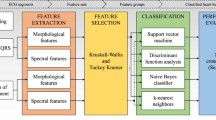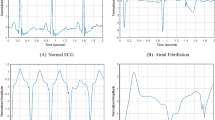Abstract
The electrocardiogram signal (ECG) has been widely used as a diagnostic tool for many heart related diseases. In this work, we present a novel method for the prediction and detection of ventricular arrhythmia using a unique set of ECG features extracted from two consecutive cardiac cycles. Two databases of the heart signal recordings from MIT Physionet and the American Heart Association were used as training, test, and validation sets to evaluate the performance of the proposed method. Linear Discriminant Analysis was used to differentiate between normal and abnormal ECG signals. The discriminatory properties of the ECG features were evaluated by many k-fold cross validations. The proposed method achieved: an accuracy of 99.1%, sensitivity of 98.95%, precision of 98.39%, and area under the receiver operating characteristics curve of 99.97% on the out-of-sample validation data by tenfold cross validation with 5 s window size. Furthermore, the method was capable of predicting the onset of ventricular arrhythmia up to 3-hours earlier; this is the earliest prediction interval compared to any published work so far.











Similar content being viewed by others
References
Schleifer, J. W., & Srivathsan, K. (2013). Ventricular arrhythmia: State of the art. Cardiology Clinics, 31(4), 595–605.
Zipes, D. P., & Wellens, H. J. (1998). Sudden cardiac death. Circulation, 98(21), 2334–2351.
Garratt, C. J., Statter, C., & Statters, D. (2001). Mechanisms and management of cardiac arrhythmias. London: BMJ Books.
De Chazal, P., O’Dwyer, M., & Reilly, R. B. (2004). Automatic classification of heartbeats using ECG morphology and heartbeat interval features. IEEE Transactions on Biomedical Engineering, 51(7), 1196–1206.
Amann, A., Tratnig, R., & Unterkofler, K. (2007). Detecting ventricular fibrillation by time-delay methods. IEEE Transactions on Biomedical Engineering, 54(1), 174–177.
Sayadi, O., Shamsollahi, M. B., & Clifford, G. D. (2010). Robust detection of premature ventricular contractions using a wave-based Bayesian framework. IEEE Transactions on Biomedical Engineering, 57(2), 353–362.
Zhang, X.-S., Zhu, Y.-S., Thakor, N. V., & Wang, Z.-Z. (1999). Detecting ventricular tachycardia and fibrillation by complexity measure. IEEE Transactions on Biomedical Engineering, 46(5), 548–555.
Jekova, I. (2007). Shock advisory tool: Detection of Life-threatening cardiac arrhythmias and shock success prediction by means of a common parameter set. Biomedical Signal Processing and Control, 2(1), 25–33.
Alonso-Atienza, F., Morgado, E., Fernandez-Martinez, L., García-Alberola, A., & Rojo-Alvarez, J. (2014). Detection of life-threatening arrhythmias using feature selection and support vector machines. IEEE Transactions on Biomedical Engineering, 61, 832–840.
Pardey, J. (2007). “Detection of ventricular fibrillation by sequential hypothesis testing of binary sequences,” in IEEE computers in cardiology, pp. 573–576.
Li, Q., Rajagopalan, C., & Clifford, G. (2013). Ventricular fibrillation and tachycardia classification using machine learning method. IEEE Transactions on Biomedical Engineering, 61, 1607–1613.
Pan, J., & Tompkins, W. J. (1985). A real-time QRS detection algorithm. IEEE Transactions on Biomedical Engineering, 3, 230–236.
Bayasi, N., Tekeste, T., Saleh, H., Khandoker, A., Mohammad, B., & Ismail, M. (2014). Adaptive technique for P and T wave delineation in electrocardiogram signals. In International conference of the IEEE on engineering in medicine and biology society, 2014.
Goldberger, A. L., Amaral, L. A. N., Glass, L., Hausdorff, J. M., Ivanov, P. C., Mark, R. G., et al. (2000). PhysioBank, PhysioToolkit, and PhysioNet: Components of a new research resource for complex physiologic signals. Circulation, 101(23), e215–e220.
Nobel, J. J. [Online]. Available: https://www.ecri.org/Products/Pages/AHA_ECG_DVD.aspx
Finkler, M. S. “Lab 10: Cardiovascular Physiology,” Indian University, pp. 1–5.
Wang, H., Khoshgoftaar, T.M., & Gao, K. (2010). A Comparative Study of Filter-Based Feature Ranking Techniques. In 2010 IEEE international conference on information reuse and integration (IRI). IEEE, pp. 43–48.
Forman, G. (2003). An extensive empirical study of feature selection metrics for text classification. The Journal of Machine Learning Research, 3, 1289–1305.
Fisher, R. A. (1936). The use of multiple measurements in taxonomic problems. Annals of eugenics, 7(2), 179–188.
Loog, M., Haeb-Umbach, R., et al. (2000). Multi-class linear dimension reduction by generalized Fisher criteria. In INTERSPEECH. Citeseer, pp. 1069–1072.
Acknowledgements
This work was supported by the Mubadala-SRC Center of Excellence for Energy Efficient Electronic Systems research contract 2013-HJ2440.
Author information
Authors and Affiliations
Corresponding author
Rights and permissions
About this article
Cite this article
Bayasi, N., Tekeste, T., Saleh, H. et al. A novel algorithm for the prediction and detection of ventricular arrhythmia. Analog Integr Circ Sig Process 99, 413–426 (2019). https://doi.org/10.1007/s10470-019-01432-y
Received:
Revised:
Accepted:
Published:
Issue Date:
DOI: https://doi.org/10.1007/s10470-019-01432-y




